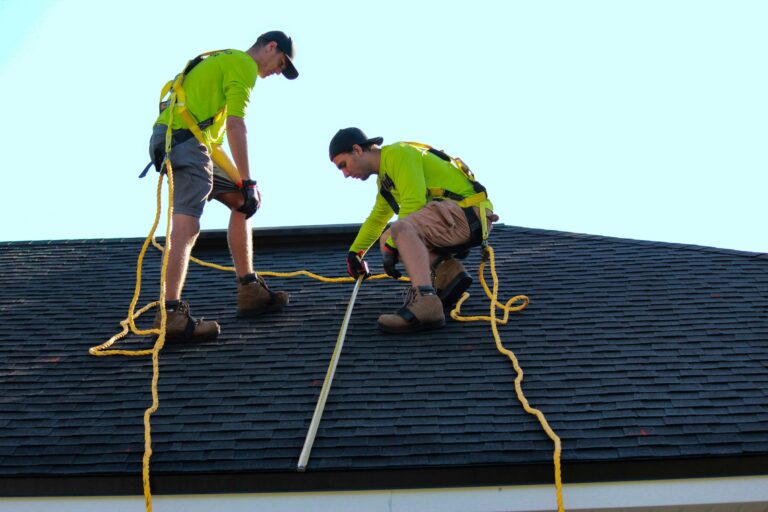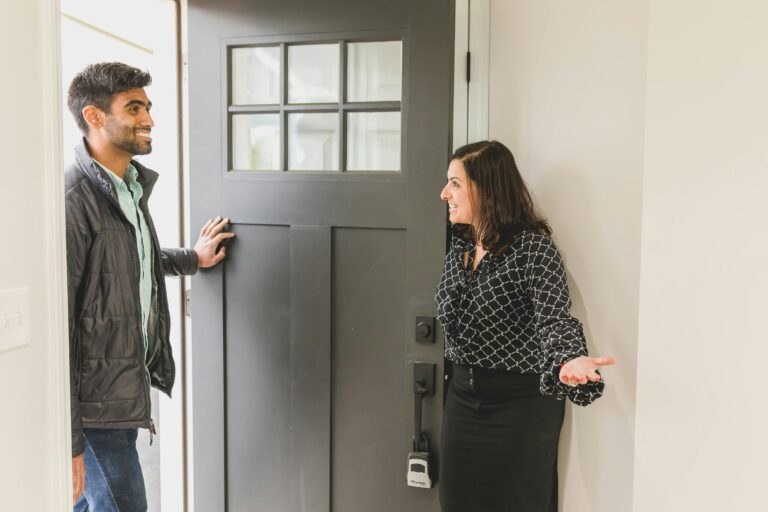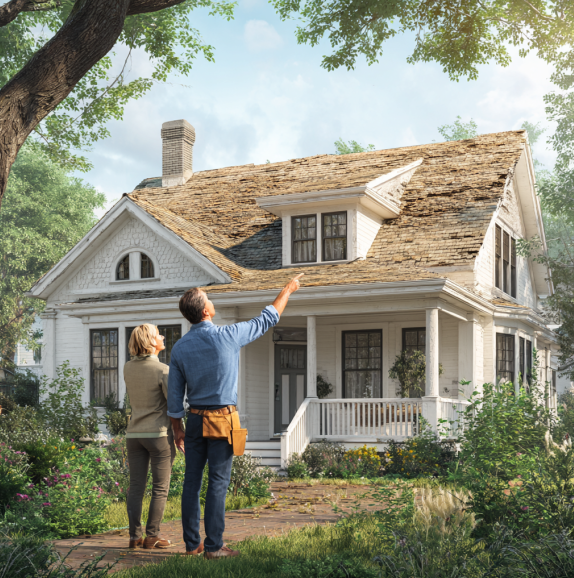Not long ago, roofing companies could thrive on reputation alone. A strong referral network, a yard sign, or a business card often meant steady work. But the way homeowners choose contractors has changed.
Most people now start their search online. They compare local listings, look at websites, and read reviews before making a call. Increasingly, they’re also asking voice assistants questions like “Who’s the best roofer near me?” or relying on AI-powered search summaries to guide their decisions. If your roofing business doesn’t appear in those results, you’re already at a disadvantage.
The traditional “truck and a card” has been replaced by the Google Business Profile, a professional website, a stream of online reviews, and optimization for SEO, AI, and voice search. Contractors who adapt to this shift can reach homeowners no matter how they search.
Key Takeaways
In this guide, you’ll learn:
- How to optimize your Google Business Profile to rank in local search results
- What makes a roofing website generate leads instead of just existing online
- Why online reviews and blog content are essential for trust
- How paid ads can speed up results when combined with organic efforts
Ready to stand out from your competition? JobNimbus Marketing is here to help.
What Do Most Roofing Companies Miss About Digital Marketing?
Most roofing companies miss that roofing digital marketing is about visibility and leads, not just being online.
One of the biggest challenges roofing contractors face today is assuming that a minimal online presence is “good enough.” They might have a simple website put together years ago, or a Facebook page with a few photos, and think that’s sufficient. The problem is that homeowners aren’t just browsing, they’re searching with intent. They’re typing specific queries like “emergency roof repair” or “best roofer in Dallas” into Google, and if your business doesn’t show up, you’re invisible at the exact moment they’re ready to hire.
That’s why digital marketing for roofing companies must be seen as more than just “being online.” It’s about being discoverable, competitive, and trusted where homeowners are actively looking. The contractors who understand this distinction are the ones consistently closing more jobs, while others wait on word-of-mouth referrals that may or may not come through.
Core terms every roofer should understand:
- SEO (Search Engine Optimization): Improving your website and online content so Google ranks you higher when homeowners search for services like “roof repair company.” A strong SEO strategy includes optimized service pages, local landing pages, and fresh content that matches what people are searching.
- AIO/LLMO (AI Optimization): Structuring content so AI systems and large language models can parse, summarize, and surface it in responses—the kind used in AI-powered search and digital assistants.
- Voice Search Optimization: Structuring content in a natural, conversational format so assistants like Siri, Alexa, or Google Assistant can read it aloud when homeowners ask questions.
- PPC (Pay-Per-Click Ads): Paid ads on Facebook or on Google’s SERPs (Search Engine Results Pages), which direct people to your business. You only spend money when someone clicks on your listing. For example, a roofer bidding on “storm damage roof repair” pays only when a homeowner actively seeking that service clicks through.
- Lead Generation: The process of turning digital visibility into real opportunities, such as phone calls, estimate requests, and scheduled jobs.
Roofing companies that treat digital marketing as a connected system, combining SEO, AI, and voice optimization, reviews, a professional website, and paid ads, build a steady and predictable pipeline of leads. Those who only experiment with one piece rarely see consistent results.
Digital marketing for roofing companies works when it’s intentional and integrated. The roofers who approach it strategically don’t just compete locally—they become the go-to choice in their market.
How Does Google Decide Which Roofing Businesses Rank Higher?
Google ranks roofing businesses by proximity, relevance, and authority.
When a homeowner searches for a roofer, they usually want fast, reliable service nearby. Google’s job is to connect them with the businesses most likely to meet that need. Whether results appear on a phone screen, in an AI-powered search summary, or are read aloud by a voice assistant, the same factors apply. For roofing contractors, understanding and improving these factors is the key to showing up consistently where it matters most.
The three ranking factors explained:
- Proximity: Google favors businesses physically close to the searcher. If someone in Tampa searches for “roof repair service,” they won’t see roofers from Miami. This is why it’s critical to list accurate service areas on your Google Business Profile and create local landing pages for every town or neighborhood you serve. The closer and clearer you are, the more likely you’ll appear in results.
- Relevance: Google looks at how well your online presence matches the search terms. A vague listing that only says “contractor” is less effective than one that specifies “residential roof repair, storm damage repair, and metal roofing.” For AI-generated summaries, relevance also means structuring your site with FAQs, service pages, and blog content that answer specific homeowner questions in clear, direct language. The more relevant your content, the more likely AI tools will highlight it.
- Authority: Trust is everything. Google evaluates signals like the number and quality of reviews, how often your profile and site are updated, and whether you publish useful content. Authority isn’t built overnight; it grows from consistent effort. For example, roofers with a steady stream of positive reviews and an active blog are seen as more reliable, which raises their chances of being recommended in both traditional search and AI-driven results.
Many roofers assume that being nearby is enough to secure leads. But proximity only gets you in the door. To dominate search results, you also need to demonstrate relevance through clear, targeted content and authority through reviews and activity.
Roofing companies that address all three factors—proximity, relevance, and authority—consistently outperform their competitors. They don’t just show up in Google Maps; they become the roofer that AI tools, voice assistants, search engines, and homeowners trust most.
Why Is Google Business Profile So Important for Roofers?
A Google Business Profile is important because it helps roofers show up in Google Maps and local search results.
For many homeowners, a Google Business Profile (GBP) is their very first interaction with your roofing company. It appears directly in Google Maps and the “local pack” at the top of search results, often before a customer even clicks through to your website. This makes GBP one of the most influential pieces of your online presence. It’s so important, in fact, that we wrote an entire article just about creating the perfect local business listing.
A complete and active profile gives homeowners everything they need to make a quick decision: reviews, business hours, a direct call button, and photos of your work. If your profile is incomplete or outdated, you risk losing leads to competitors who look more reliable and professional at first glance. In fact, for many roofers, their GBP generates more calls than their actual website.
How to optimize your GBP for SEO, AI, and voice search:
- Claim and verify your listing: Verification confirms you’re the rightful owner and allows you to control the information shown. Without it, competitors or even random users could suggest changes. Verified listings also have a higher chance of being pulled into AI-generated search summaries and voice assistant results.
- Complete every detail: Fill out every section with accurate hours, service descriptions, and contact information. Use specific keywords like “roof replacement” or “storm damage repair” so Google clearly understands what you offer. AI and voice search rely heavily on this structured information to recommend your business.
- Use professional photos: Upload high-quality images of your team, branded trucks, before-and-after project photos, and even drone shots of finished roofs. Homeowners want visual proof of your credibility, and Google favors profiles with regular photo updates.
- Post updates regularly: Share seasonal maintenance tips, highlight completed jobs, or announce promotions. Regular posts show activity and reliability, while signaling to both Google and AI systems that your business is engaged and trustworthy.
A well-optimized GBP doesn’t just help you get found, it helps you get chosen. Homeowners are far more likely to call a roofer who has clear contact details, fresh photos, recent reviews, and active updates. Roofers who treat GBP as a living, breathing part of their roofing digital marketing often see it become their single biggest source of inbound leads.
What Makes a Roofing Website a True Lead Generator?
A roofing website generates leads when it’s fast, mobile-friendly, and optimized for local, AI, and voice search.
Your website isn’t just a digital business card; it’s the central hub of your entire marketing strategy. Whether a homeowner finds you through Google Maps, an ad, or a voice assistant, they’ll almost always end up on your site before deciding to hire you. If that experience feels outdated, confusing, or slow, you risk losing the lead instantly.
A true lead-generating roofing website doesn’t just display information; it actively guides visitors from curiosity to action. Every click, page, and form should be designed to reassure homeowners and make it easy for them to take the next step.
Key elements of a lead-generating roofing site:
- Fast loading speeds: Homeowners won’t wait. Studies show that pages taking more than three seconds to load have significantly higher bounce rates. Investing in good hosting, compressed images, and a streamlined design can mean the difference between a lead and a lost customer.
- Mobile-first design: With more than 60% of local service searches coming from mobile devices, your site must look professional and function seamlessly on smartphones. Navigation menus should be simple, buttons should be thumb-friendly, and your phone number should always be clickable.
- Strong calls-to-action: Don’t make visitors hunt for your contact form. Prominent buttons like “Call Now” or “Get a Free Estimate” should be visible on every page. Multiple touchpoints increase the likelihood that a visitor will convert into a lead.
- Dedicated service pages: Instead of lumping everything under “Services,” create a separate page for each offering, such as “Roof Repair,” “New Roof Installation,” and “Storm Damage Repair.” This not only helps homeowners understand your specialties but also improves SEO, AI, and voice search by targeting specific keywords.
- Local landing pages: If you serve multiple towns, give each one its own page—“Roof Replacement in Schaumburg, IL” or “Roof Repair in Buffalo, NY.” This boosts local SEO and ensures you’re visible in voice and AI-driven searches that highlight hyperlocal providers.
- FAQ-style content: Homeowners often ask questions like “How much does a roof replacement cost?” or “What should I do after hail damage?” Creating detailed blogs or FAQs with strong Q&A sections improves your chances of being featured in voice search results and AI summaries while also building trust with readers.
When done right, your website becomes more than a digital brochure; it’s a round-the-clock sales tool. It builds confidence with homeowners, positions you as a trusted expert, and makes it simple for visitors to contact you.
Roofers who invest in modern, SEO- and AI-optimized websites consistently see higher conversion rates and stronger ROI. A strong website isn’t just a marketing expense; it’s one of the most profitable assets a roofing company can own.
Why Are Online Reviews Critical for Roofing Companies?
Online reviews are the new word-of-mouth for roofers, directly impacting trust, SEO, and AI search visibility.
Reputation has always been central to the roofing business. In the past, it was built through neighbors talking over fences, referrals from friends, or a homeowner seeing your work on a nearby house. Today, that same reputation is measured online through Google reviews and other review platforms.
Most homeowners won’t hire a roofer without first checking reviews. In fact, surveys show that nearly 9 out of 10 consumers trust online reviews as much as personal recommendations. Even more importantly, businesses with a steady flow of fresh, positive reviews rank higher in Google search, show up more often in Google Maps, and are more likely to be included in AI-generated summaries and voice assistant results.
How to create a steady flow of reviews:
- Ask right away: The best time to request a review is immediately after a job is complete, when the homeowner is most satisfied. Train your crews to politely ask at the end of the project and provide a simple next step.
- Simplify the process: Make leaving a review easy. Send a text or email with a direct link to your Google review page, because no one wants to hunt around to figure it out. The easier the process, the higher the response rate.
- Respond consistently: A quick thank-you to positive reviews shows appreciation, while a professional, calm response to negative reviews demonstrates accountability. This not only reassures homeowners but also signals to Google and AI systems that your business is responsive and engaged.
- Leverage your best reviews: Don’t let great feedback sit hidden on Google. Highlight standout reviews on your website, include them in sales proposals, and share them on social media. They reinforce your reputation across multiple touchpoints.
Reviews are more than just stars on a page; they’re one of the most powerful trust signals you can build. They influence both human decisions and search engine algorithms.
Roofers who commit to consistently requesting, managing, and showcasing reviews not only earn more trust with homeowners but also gain higher visibility in Google search, AI-powered results, and voice assistant recommendations. In competitive markets, reviews can be the deciding factor that sets you apart.
Need help? We’ve mastered communication for roofing contractors that help build your reviews.
How Can Blogging Help Roofers Get More Leads?
Blogging helps roofers rank for homeowner questions and appear in AI and voice search answers.
When homeowners suspect a roofing issue, they don’t usually start by searching for a contractor right away. Instead, they begin by asking questions: “How much does a roof replacement cost?” “What are the signs of hail damage?” “Is roof repair covered by insurance?” Blogging allows roofers to meet homeowners at this early research stage, build trust, and guide them toward choosing a professional.
Digital marketing for roofing companies includes creating content that answers these questions clearly and helpfully, positioning your company as a knowledgeable resource. That authority pays off in two ways: it attracts homeowners earlier in their decision process, and it increases your chances of being featured in AI-powered search summaries and voice assistant results, where concise, well-structured answers are prioritized.
Examples of effective roofing blog topics:
- Cost-focused: “How Much Does a Roof Replacement Cost in Mission Viejo, CA?” helps attract homeowners budgeting for a project. Adding cost ranges, factors that affect pricing, and tips for comparing estimates makes the content more useful and shareable.
- Problem-focused: “5 Signs You Need Roof Repair Before Winter” addresses seasonal concerns and creates urgency. Homeowners reading this are often close to booking a contractor.
- Insurance-focused: “Does Homeowners Insurance Cover Storm-Damaged Roofs?” clarifies a confusing but common topic. A blog like this not only ranks well but also positions you as a helpful guide during stressful situations.
- Material comparisons: “Metal Roof vs. Asphalt Shingles: Which Is Better for Seattle Homes?” attracts homeowners still weighing their options. Detailed pros and cons encourage readers to trust your expertise when making their decision.
Why consistent blogging pays off:
- More search traffic: Every blog is a new chance to rank for a different keyword, multiplying the ways homeowners can find you online.
- Greater authority: Regular, helpful posts signal to both homeowners and Google that you’re an expert who stays active in your field.
- Stronger trust: By answering questions openly, you show homeowners you care about education, not just sales. This builds confidence before they ever call.
- AI and voice visibility: Blogs written in a natural, Q&A format are more likely to be selected as featured snippets, read aloud by voice assistants, or included in AI-generated search summaries.
Blogging isn’t just about filling space on your website; it’s about creating a library of helpful content that works for you 24/7. Roofers who blog consistently see long-term growth in traffic, rankings, and leads. More importantly, they position themselves to thrive in an AI- and voice-driven search landscape where direct, trusted answers win.
What Should Roofers Consider Before Choosing a Marketing Strategy?
Roofers should consider budget, urgency, competition, and growth goals before picking a marketing plan.
No two roofing companies are the same. Some need a flood of leads immediately after a major storm, while others want steady growth that scales over years. Choosing the right marketing approach isn’t about copying competitors; it’s about aligning your strategy with your specific goals, resources, and market conditions.
A thoughtful strategy helps avoid wasted ad spend, prevents underinvestment in organic marketing, and ensures that every dollar you put into marketing works toward your long-term success.
Questions to ask yourself before choosing a strategy:
- Budget: Do you have the cash flow to fund monthly paid ads, or would a longer-term investment in SEO and AI optimization provide better value? Paid ads deliver speed but require ongoing spend, while organic strategies compound over time and continue generating results long after the work is done.
- Timeline: Do you need jobs booked this week to keep crews busy, or can you wait three to six months for SEO and voice optimization to begin really building momentum? Urgency often dictates how heavily you should lean into paid advertising.
- Support: Do you have someone in-house who understands roofing digital marketing, or will you need an external roofing digital marketing partner to execute your strategy? Many small roofing teams don’t have the bandwidth for daily updates, ad monitoring, or SEO content creation. Outsourcing ensures consistency.
- Competition: How many roofing companies are active in your market? In high-competition areas, it’s often not enough to rely on one tactic. You may need a mix of SEO, AIO (AI Optimization), voice optimization, reviews, and ads to stand out.
- Growth goals: Are you content keeping a single crew busy, or do you want to expand into multiple teams and service areas? Smaller companies may focus on local SEO and reviews, while growth-focused businesses need scalable systems that work across regions.
Why this matters:
Taking time to answer these questions honestly helps you avoid quick-fix decisions that drain your budget without delivering lasting value. Roofers who balance SEO, AI optimization, and paid advertising typically see the strongest results because their strategies work in both the short term and the long run.
The roofing companies that thrive are the ones that build flexible marketing strategies, able to deliver leads now, while also investing in visibility that will continue to generate business for years.
Should Roofers Use Organic Marketing, Paid Ads, or Both?
The best roofing strategy combines SEO, AI, and voice optimization for authority with paid ads for speed.
One of the biggest mistakes roofers make is choosing just one type of marketing. Some go all-in on paid ads, only to find themselves dependent on a constant ad spend with no lasting visibility. Others focus only on SEO, waiting months for results and missing out on immediate opportunities. Neither approach alone is enough to build a stable pipeline.
The most effective roofing companies use both. Organic roofing digital marketing provides a strong foundation for long-term authority and trust, while paid ads act as an accelerator that delivers instant visibility and leads.
How they complement each other:
- Organic marketing (foundation): SEO ensures your business ranks in Google search, while AI and voice optimization prepare your content for the way homeowners are increasingly searching. Reviews build credibility, and consistent blogs establish your authority as a trusted expert. Together, these create sustainable visibility that compounds over time—bringing in leads month after month, even when you’re not actively spending on ads.
- Paid ads (accelerator): Google Local Services Ads (LSAs) put you at the very top of search results with a “Google Guaranteed” badge, instantly boosting trust. Pay-per-click (PPC) campaigns capture high-intent homeowners searching terms like “emergency roof repairs,” delivering jobs right when you need them most. These ads keep crews busy and cash flow steady while your organic presence grows stronger in the background.
Why both matter:
By combining organic and paid marketing, roofers get the best of both worlds: fast, reliable lead flow today and a scalable system that reduces dependence on paid ads over time. This dual approach ensures you don’t just survive busy seasons, but that you thrive year-round.
Contractors who embrace both strategies build resilience. They aren’t at the mercy of ad costs skyrocketing or search rankings fluctuating. Instead, they create a roofing digital marketing ecosystem that produces consistent results, adapts to market shifts, and supports growth at every stage of their business.
Final Takeaway: Why a Complete Digital Presence Wins for Roofers
A strong online presence is the new “truck and a card” for roofers.
For decades, roofing companies built their reputations through trucks with logos, business cards, and word-of-mouth. Those tools aren’t gone, but they’re no longer enough on their own. Homeowners today turn first to search engines, voice assistants, and even AI-generated summaries to find and evaluate contractors. If your business isn’t visible in those channels, you’re likely losing work to competitors who are.
That’s why a complete digital presence matters. It’s not about choosing between SEO and ads, or between reviews and a website. It’s about building a connected system where every part supports the other:
- SEO makes you visible in traditional search.
- AI optimization ensures your content is ready for emerging search tools.
- Voice search optimization helps you get recommended by assistants like Siri and Alexa.
- Reviews provide the trust that convinces homeowners to call.
- Paid ads keep leads flowing while your organic authority grows.
Roofers who commit to this full approach create more than just visibility; they create predictability. Instead of waiting for referrals or hoping for storm-driven demand, they build a steady, scalable pipeline of leads that grows with their business.
If you want to win in today’s roofing market, your online presence must become as essential as your tools and trucks.
Want results without wasting time or budget? Schedule your free strategy session today with JobNimbus Marketing and start building the digital foundation your business needs to grow.
FAQs About Roofing SEO, AI, and Voice Optimization
How do roofing SEO services help generate leads?
Roofing SEO services improve your visibility on search engines like Google, so homeowners find your business first. More visibility leads directly to more calls, estimate requests, and booked jobs.
How long does it take for roofing SEO services to work?
Roofing SEO services usually take three to six months to show measurable results. Paid ads can bridge the gap while SEO builds momentum over time.
Are roofing SEO services better than paid ads?
Roofing SEO services provide steady, long-term visibility, while paid ads deliver immediate results. The most effective strategy combines both for balance.
Do roofing SEO services include managing Google reviews?
Yes, many roofing digital marketing services include reputation management. Reviews are a major factor in local rankings and influence whether homeowners choose you.
Why is local SEO important for roofing companies?
Local SEO ensures your business appears in the towns and neighborhoods you actually serve. This leads to higher-quality leads and fewer wasted calls.
How can roofers optimize for voice search?
Roofers can optimize for voice search by using natural, conversational language on their websites and creating FAQ-style content. Voice assistants often pull answers directly from concise Q&A sections.
Why does AI optimization matter for roofing businesses?
AI optimization matters because search engines are increasingly using AI to generate summaries and recommendations. Roofers with clear, structured content are more likely to be featured in these results.
What’s the difference between SEO and AI optimization for roofers?
SEO helps roofers rank in traditional Google search results, while AI optimization prepares content for AI-generated summaries and recommendations. Both work together to improve visibility.
How do reviews affect AI and voice search results?
Reviews help determine trust and relevance, which AI and voice assistants use when recommending businesses. A steady stream of recent 5-star reviews improves your chances of being chosen.
Can roofers appear in “near me” searches on voice assistants?
Yes, roofers can appear in “near me” searches if their Google Business Profile is fully optimized with accurate service areas, reviews, and business details. You do not have to actually use the words “…near me” on your site to be found in these search results.
Table of Contents
Keep on learnin'
Related Articles

Winning the Offseason: Fall Roofing Marketing Strategies That Win Customers

Roofing Marketing Strategies: Timing Campaigns for Maximum Impact

Creating the Perfect Local Business Listing For Your Roofing Business



